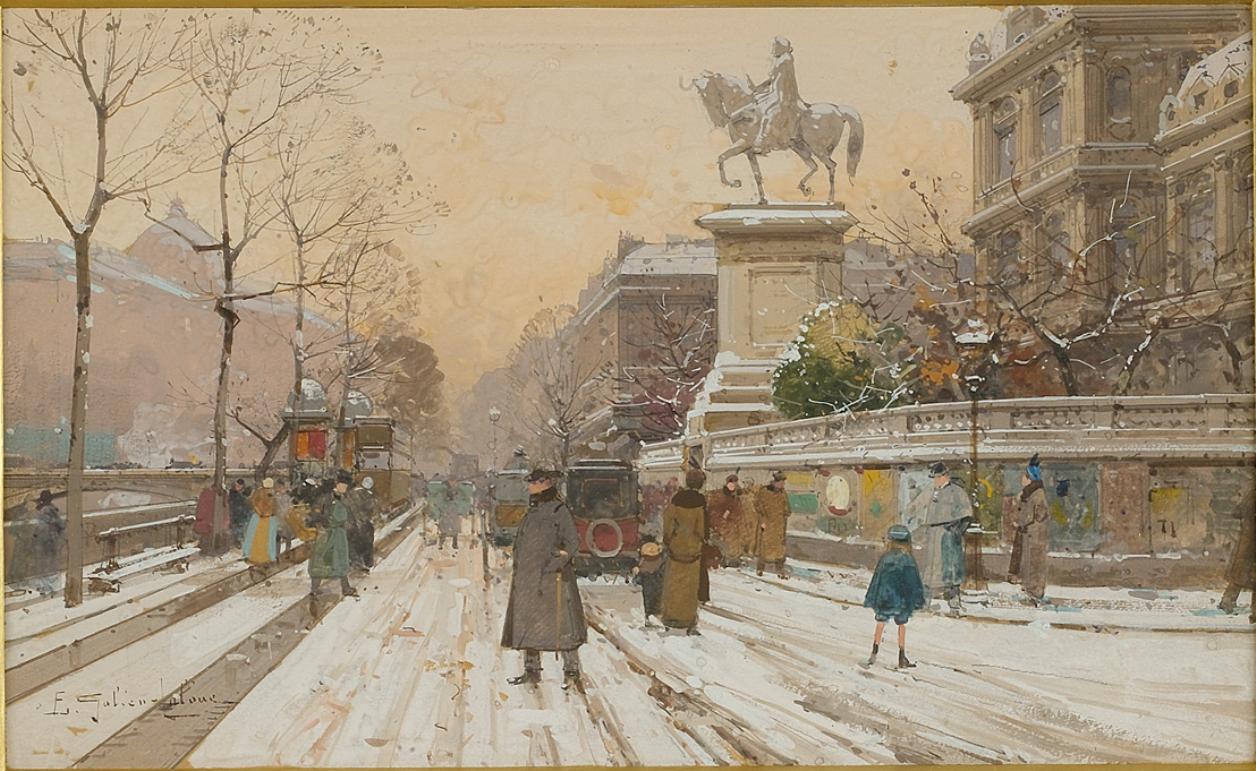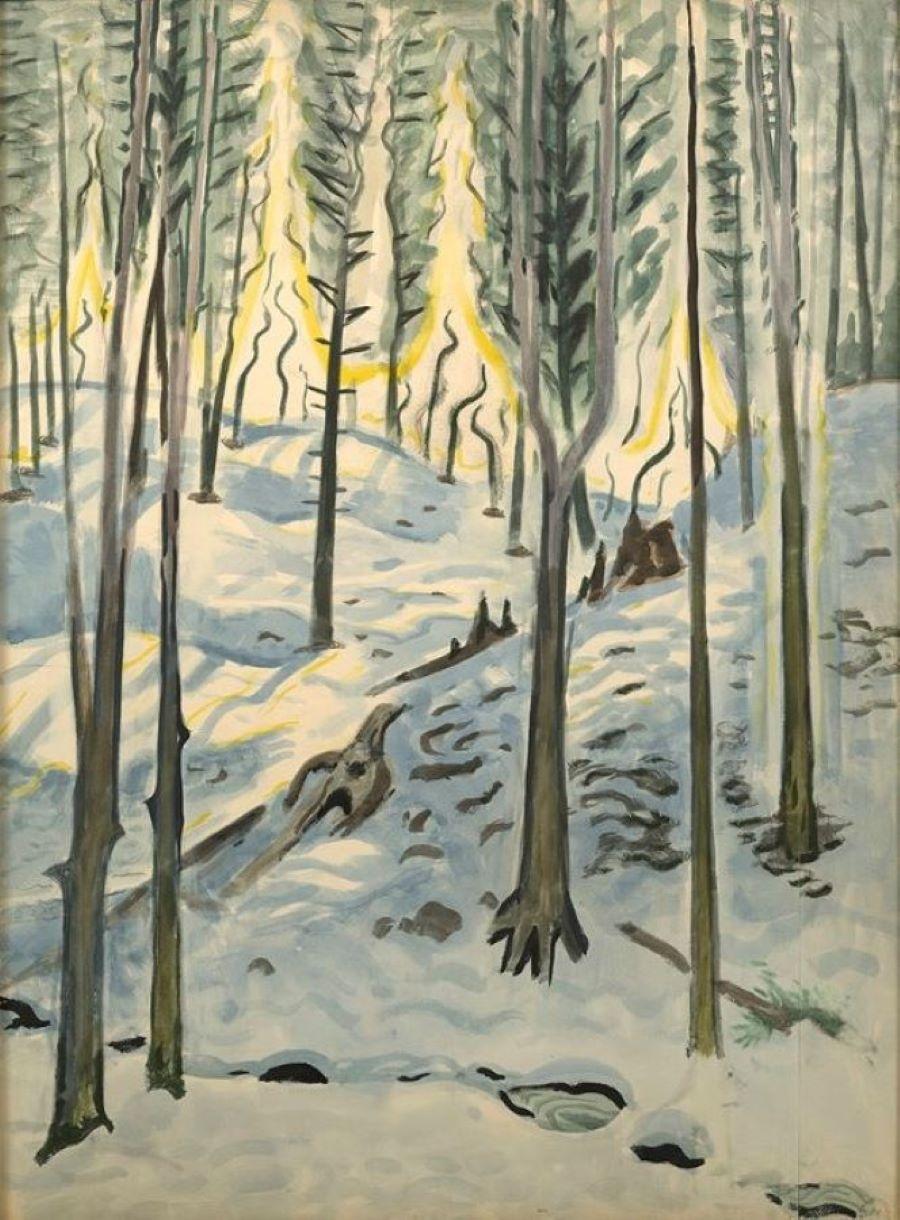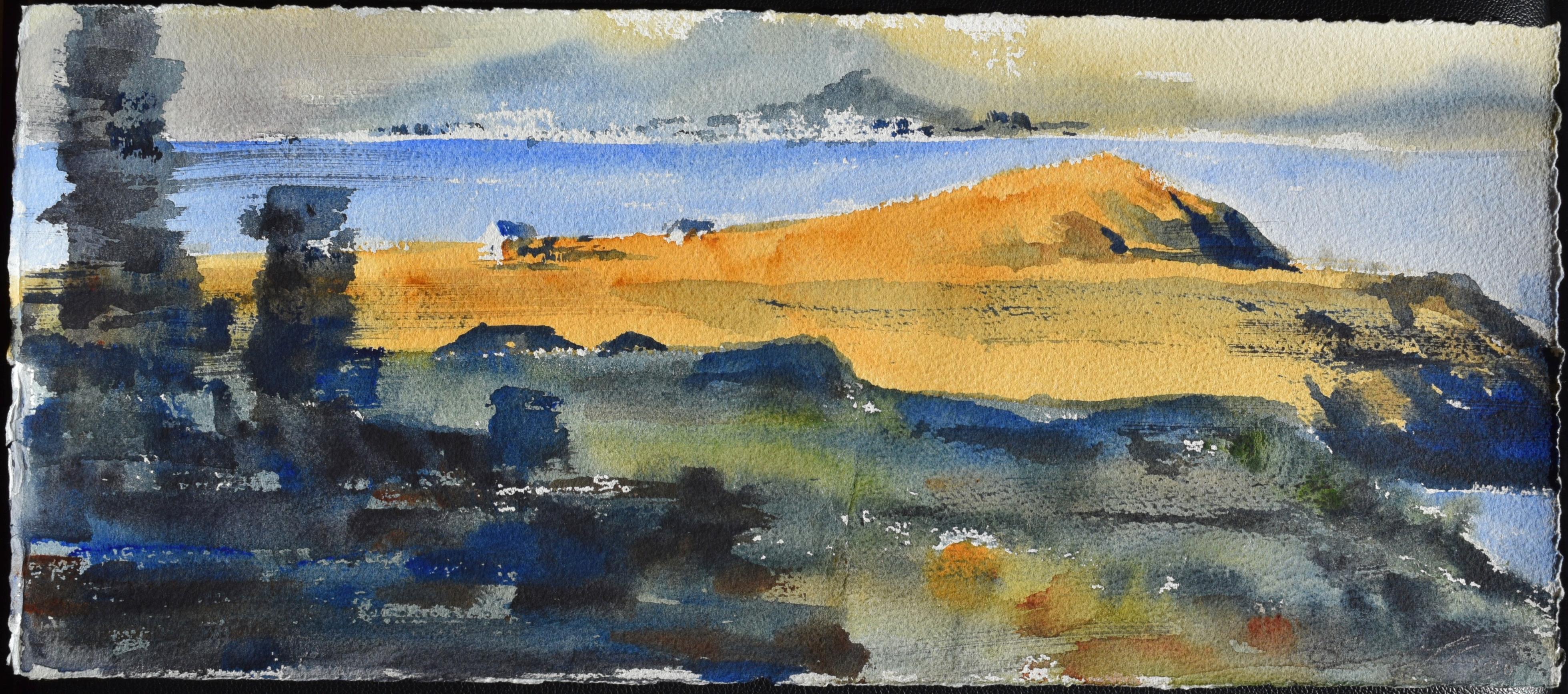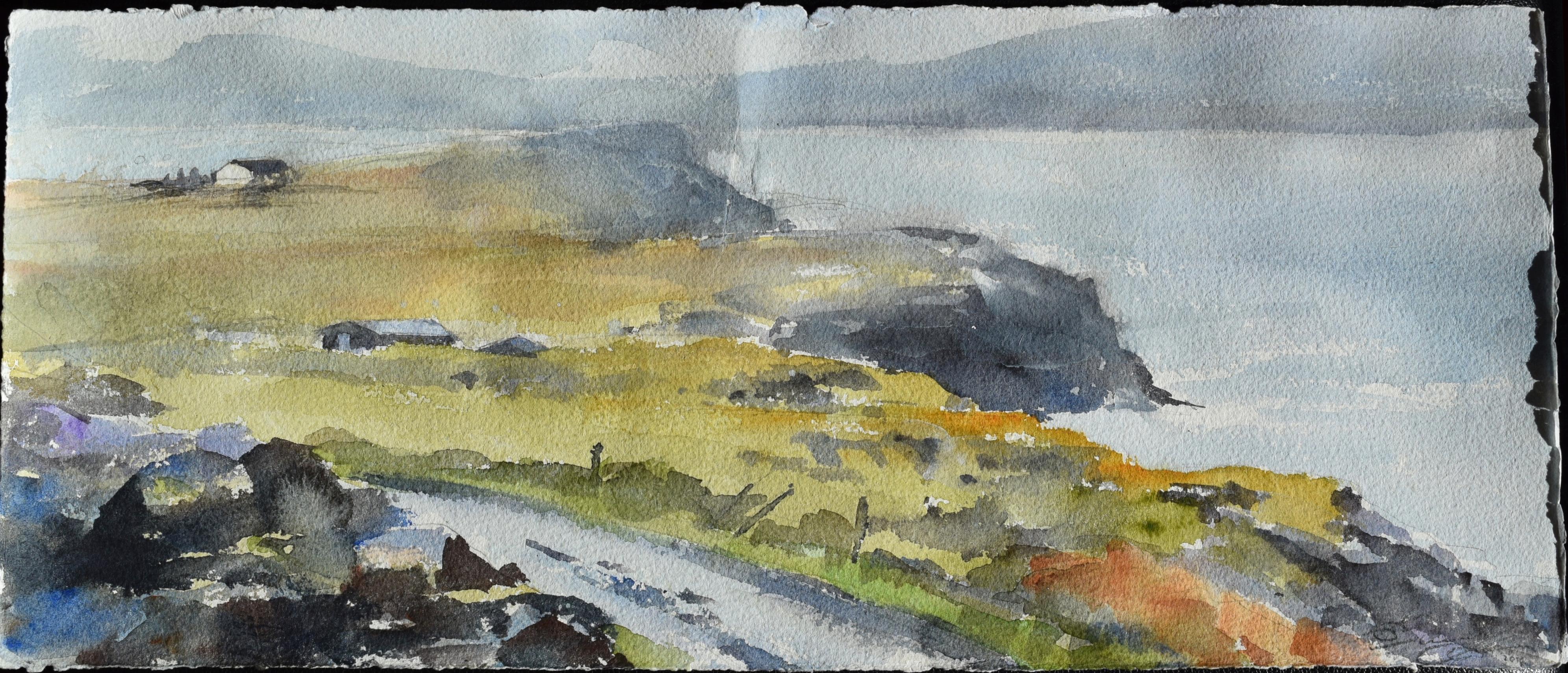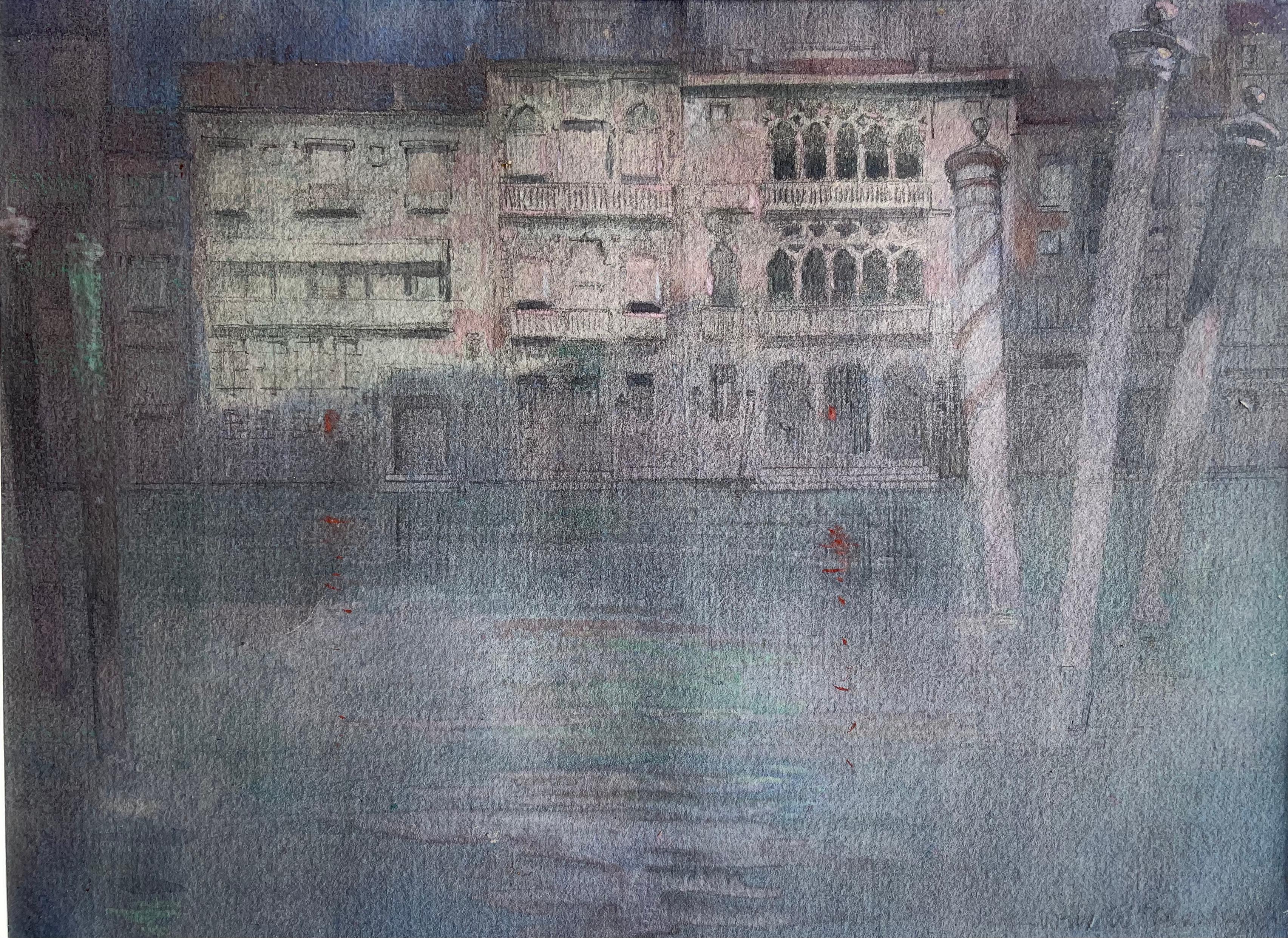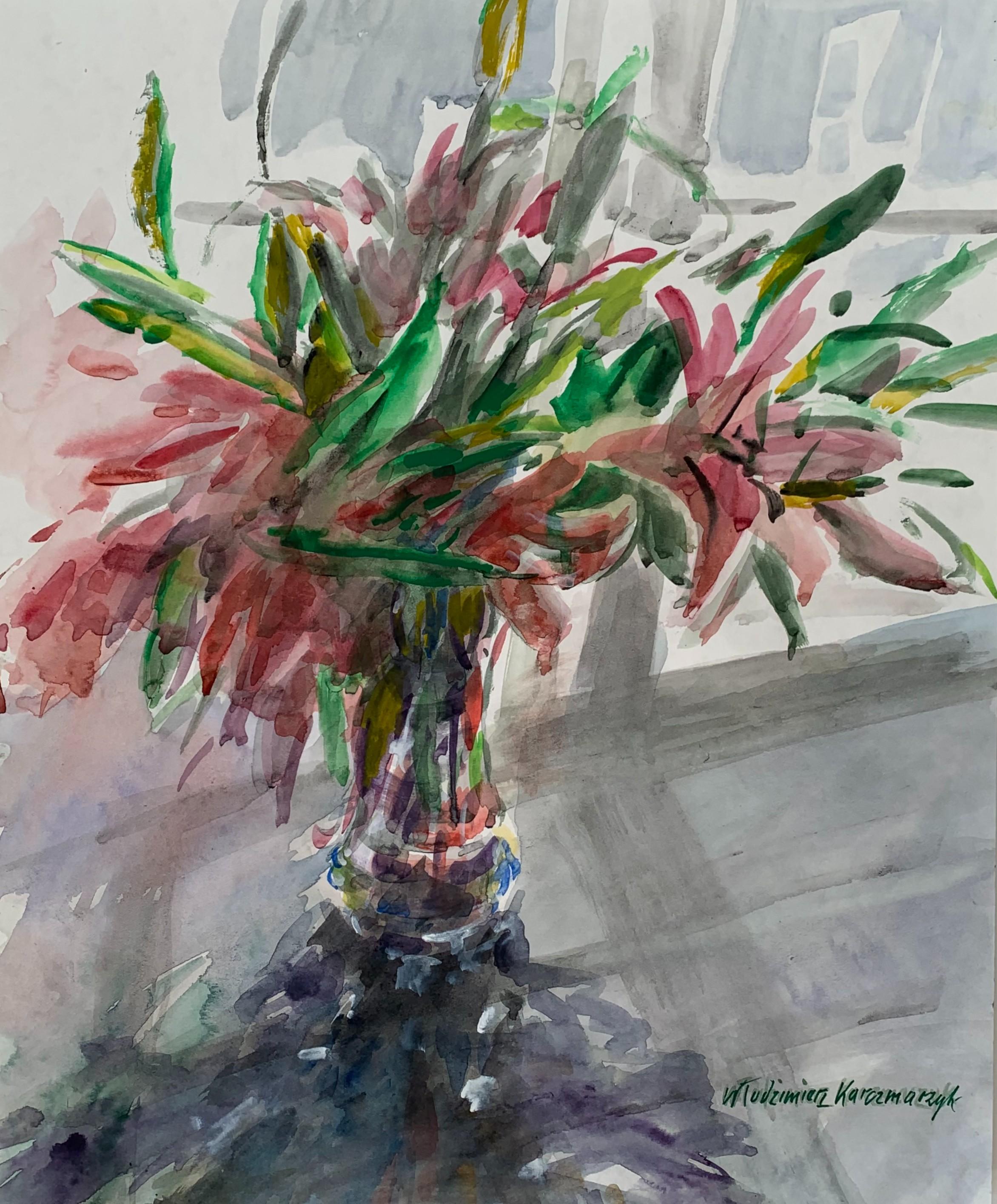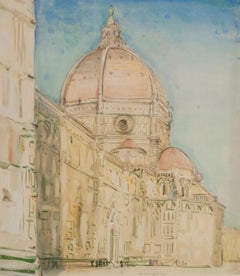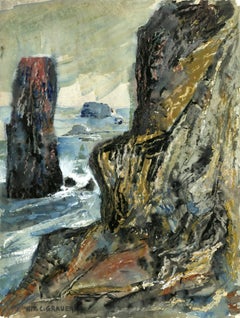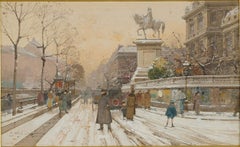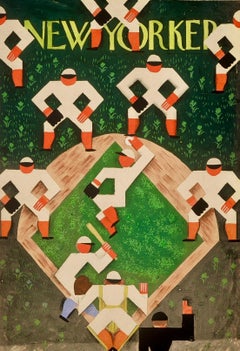
untitled (Summer Sentry)
View Similar Items
Want more images or videos?
Request additional images or videos from the seller
1 of 2
Emma Lane Payneuntitled (Summer Sentry)
About the Item
- Creator:Emma Lane Payne (1857-1943, American)
- Dimensions:Height: 11.63 in (29.55 cm)Width: 8.88 in (22.56 cm)
- Medium:
- Period:
- Condition:
- Gallery Location:Fairlawn, OH
- Reference Number:Seller: FA61201stDibs: LU1401071323
About the Seller
5.0
Recognized Seller
These prestigious sellers are industry leaders and represent the highest echelon for item quality and design.
Platinum Seller
These expertly vetted sellers are 1stDibs' most experienced sellers and are rated highest by our customers.
Established in 1978
1stDibs seller since 2013
711 sales on 1stDibs
Typical response time: 1 hour
Associations
International Fine Print Dealers Association
More From This SellerView All
- The Duomo, FlorenceBy Donald Shaw MacLaughlanLocated in Fairlawn, OHThe Duomo, Florence Watercolor, 1914 Signed and dated lower center edge (see photo) Florence Cathedral, formally the Cattedrale di Santa Maria del Fiore, is the cathedral of Florence, Italy. It was begun in 1296 in the Gothic style to a design of Arnolfo di Cambio and was structurally completed by 1436, with the dome engineered by Filippo Brunelleschi. Condition: Excellent Image size: 16 3/4 x 14 1/2 inches Frame size: 24 1/4 x 22 inches Donald Shaw MacLaughlan was born in Charlottetown, Prince Edward Island, Canada on November 9, 1876. His family moved to Boston, Massachusetts in 1890 where he began to experiment with different art media; watercolor, oil painting and finally, etching – with a few attempts at lithography. He spent much of his early years at the Boston Public Library studying the work of printmakers, from Durer and Rembrandt to the 18th century English, French and Italian masters. Like many American artists of the time MacLaughlan traveled to Europe to study in Paris, enrolling in the Ecole des Beaux Arts and studied further with Jean Leon Gerome and Jean Paul Laurens. In 1899 he began producing etchings, which became his major interest until his death in 1938. He became acquainted with James NcNeill Whistler (1834-1903) and other artists who created etchings and spent time studying the etchings of Rembrandt van Rijn (1606-1669) and other old masters in the collection of the Bibliothèque Nationale. Both Rembrandt and Whistler would have major influences on his art. In 1900 he created a set of 25 etched views of Paris and in 1901 exhibited two etchings in the Salon de la Société Nationale des Beaux-Arts. He returned to the U.S. in 1903, then went back to Paris the following year. He traveled extensively in Europe, visiting England, Switzerland, Italy and Spain as well as various locales in France. His etched views of Venice were well-known. MacLaughlan exhibited views of Paris, Rouen, Normandy and Italy in 1906 in a solo show at the American Art Association Galleries in Paris. He also displayed his work in the 1906 exhibitions of the Société Nationale des Beaux-Arts and the Société des Peintres-Graveurs Français. MacLaughlan even instructed other expatriate Canadian artists then living in Paris, most notably Clarence...Category
1910s American Modern Landscape Drawings and Watercolors
MaterialsWatercolor
- untitled (Rocks along the Coast)By William C. GrauerLocated in Fairlawn, OHuntitled (Rocks along the Coast) Gouache and watercolor on paper, c. 1950 Signed with the estate stamp signature lower left (see photo) This is a preliminary study for a large exhibition painting...Category
1950s American Modern Drawings and Watercolor Paintings
MaterialsGouache
- Untitled (West Virginia fam valley and blue hills)By William C. GrauerLocated in Fairlawn, OHAfter creating murals for the Greenbrier Hotel in White Sulfur Springs, West Virginia in 1932, together Grauer and his wife founded and co-directed the successful Old White Art Colony, School and Gallery, which they continued to frequent during the summer months in the 1930s and 1940s. Grauer’s involvement in West Virginia also included his West Virginia murals for the West Virginia exhibitions at the 1933 Century of Progress Exhibition in Chicago and the 1939 World’s Fair in New York City. William C. Grauer (1895-1985) William C. Grauer (1895-1985) was born in Philadelphia to German immigrant parents. After attending the Philadelphia Museum School of Industrial Art, Grauer received a four year scholarship from the City of Philadelphia to pursue post graduate work. It was during this time that Grauer began working as a designer at the Decorative Stained Glass Co. in Philadelphia. Following his World War I service in France, Grauer moved to Akron, Ohio where he opened a studio in 1919 with his future brother-in-law, the architect George Evans Mitchell. Soon, the Rorimer-Brooks design company, the developer Van Swerngen brothers, as well as the Sterling Welch and Halle Bros. department stores realized the extent of Grauer's talent and eagerly employed him. Grauer’s work during this time included architectural renderings for Shaker Square, Moreland Courts, and other many other projects commissioned by Cleveland architects. Grauer also remained true to his roots as a master designer of stained glass windows. With his work in such high demand, Grauer received a commission in 1921 to paint murals for the French Grill Room of the Kansas City Club...Category
1930s American Modern Landscape Drawings and Watercolors
MaterialsWatercolor
- UntitledLocated in Fairlawn, OHUntitled Watercolor on paper, c,. 1890 Unsigned Provenance: Estate of the artist Image/Sheet size: 3 1/4 x 4 1/8 inches From Wikipedia "Francis Augustus Lathrop (June 22, 1849 – Oct...Category
1890s American Impressionist Landscape Drawings and Watercolors
MaterialsWatercolor
- Horses Leaving the BarnBy Adolf DehnLocated in Fairlawn, OHHorses Leaving the Barn Watercolor on paper, 1940 Signed and dated lower left corner (see photo) Condition: Excellent Image: 14 1/2 x 21” Frame: 25” x 31” Provenance; Associated American Artists, New York (see photo of label) Mamdouha and Elmer Holmes Bobst Displayed in an original wormy chestnut frame with OP3 Acrylic. Most probably from the AAA Dehn watercolor exhibition of 1940. Vintage original framing chosen by the artist. Note: Elmer Holmes Bobst (1884–1978) was an American businessman and philanthropist who worked in the pharmaceutical industry. His wife, Mamdouha, was also well known philanthropist. Bobst was born in Lititz, Pennsylvania. He aspired to become a doctor, but instead, he taught himself pharmacology. After his wife Ethel composed his interview letter, he became manager and treasurer of the Hoffman-LaRoche Chemical Works by 1920. When Bobst retired from the company in 1944, he was one of the nation's highest paid corporate executives. In 1945 he took charge of the ailing William Warner Company (later Warner–Lambert) and he remained board chairman until his retirement. Bobst had close connections to President Dwight Eisenhower, but was also a close friend of President Richard Nixon. Note: In 1940, the year of this watercolor, Dehn and Elizabeth Timmerman visited Waterville, MN on their way to Colorado Sprint, Colorado where Dehn was to teach lithography and watercolor. This watercolor is obviously a view of the area around Waterville. Adolf Dehn, American Watercolorist and Printmaker, 1895-1968 Adolf Dehn was an artist who achieved extraordinary artistic heights, but in a very particular artistic sphere—not so much in oil painting as in watercolor and lithography. Long recognized as a master by serious print collectors, he is gradually gaining recognition as a notable and influential figure in the overall history of American art. In the 19th century, with the invention of the rotary press, which made possible enormous print runs, and the development of the popular, mass-market magazines, newspaper and magazine illustration developed into an artistic realm of its own, often surprisingly divorced from the world of museums and art exhibitions, and today remains surprisingly overlooked by most art historians. Dehn in many regards was an outgrowth of this world, although in an unusual way, since as a young man he produced most of his illustrative work not for popular magazines, such as The Saturday Evening Post, but rather for radical journals, such as The Masses or The Liberator, or artistic “little magazines” such as The Dial. This background established the foundation of his outlook, and led later to his unique and distinctive contribution to American graphic art. If there’s a distinctive quality to his work, it was his skill in introducing unusual tonal and textural effects into his work, particularly in printmaking but also in watercolor. Jackson Pollock seems to have been one of many notable artists who were influenced by his techniques. Early Years, 1895-1922 For an artist largely remembered for scenes of Vienna and Paris, Adolf Dehn’s background was a surprising one. Born in Waterville, Minnesota, on November 22, 1895, Dehn was the descendent of farmers who had emigrated from Germany and homesteaded in the region, initially in a one-room log cabin with a dirt floor. Adolf’s father, Arthur Clark Dehn, was a hunter and trapper who took pride that he had no boss but himself, and who had little use for art. Indeed, during Adolf’s boyhood the walls of his bedroom and the space under his bed were filled with the pelts of mink, muskrats and skunks that his father had killed, skinned and stretched on drying boards. It was Adolf’s mother, Emilie Haas Dehn, a faithful member of the German Lutheran Evangelical Church, who encouraged his interest in art, which became apparent early in childhood. Both parents were ardent socialists, and supporters of Eugene Debs. In many ways Dehn’s later artistic achievement was clearly a reaction against the grinding rural poverty of his childhood. After graduating from high school in 1914 at the age of 19—an age not unusual in farming communities at the time, where school attendance was often irregular—Dehn attended the Minneapolis School of Art from 1914 to 1917, whose character followed strongly reflected that of its director, Munich-trained Robert Kohler, an artistic conservative but a social radical. There Dehn joined a group of students who went on to nationally significant careers, including Wanda Gag (later author of best-selling children’s books); John Flanagan (a sculptor notable for his use of direct carving) Harry Gottlieb (a notable social realist and member of the Woodstock Art Colony), Elizabeth Olds (a printmaker and administrator for the WPA), Arnold Blanch (landscape, still-life and figure painter, and member of the Woodstock group), Lucille Lunquist, later Lucille Blanch (also a gifted painter and founder of the Woodstock art colony), and Johan Egilrud (who stayed in Minneapolis and became a journalist and poet). Adolf became particularly close to Wanda Gag (1893-1946), with whom he established an intense but platonic relationship. Two years older than he, Gag was the daughter of a Bohemian artist and decorator, Anton Gag, who had died in 1908. After her husband died, Wanda’s mother, Lizzi Gag, became a helpless invalid, so Wanda was entrusted with the task of raising and financially supporting her six younger siblings. This endowed her with toughness and an independent streak, but nonetheless, when she met Dehn, Wanda was Victorian and conventional in her artistic taste and social values. Dehn was more socially radical, and introduced her to radical ideas about politics and free love, as well as to socialist publications such as The Masses and The Appeal to Reason. Never very interested in oil painting, in Minneapolis Dehn focused on caricature and illustration--often of a humorous or politically radical character. In 1917 both Dehn and Wanda won scholarships to attend the Art Students League, and consequently, in the fall of that year both moved to New York. Dehn’s art education, however, ended in the summer of 1918, shortly after the United States entered World War I, when he was drafted to serve in the U. S. Army. Unwilling to fight, he applied for status as a conscientious objector, but was first imprisoned, then segregated in semi-imprisonment with other Pacifists, until the war ended. The abuse he suffered at this time may well explain his later withdrawal from taking political stands or making art of an overtly political nature. After his release from the army, Dehn returned to New York where he fell under the spell of the radical cartoonist Boardman Robinson and produced his first lithographs. He also finally consummated his sexual relationship with Wanda Gag. The Years in Europe: 1922-1929 In September of 1921, however, he abruptly departed for Europe, arriving in Paris and then moving on to Vienna. There in the winter of 1922 he fell in love with a Russian dancer, Mura Zipperovitch, ending his seven-year relationship with Wanda Gag. He and Mura were married in 1926. It was also in Vienna that he produced his first notable artistic work. Influenced by European artists such as Jules Pascin and Georg Grosz, Dehn began producing drawings of people in cafes, streets, and parks, which while mostly executed in his studio, were based on spontaneous life studies and have an expressive, sometimes almost childishly wandering quality of line. The mixture of sophistication and naiveté in these drawings was new to American audiences, as was the raciness of their subject matter, which often featured pleasure-seekers, prostitutes or scenes of sexual dalliance, presented with a strong element of caricature. Some of these drawings contain an element of social criticism, reminiscent of that found in the work of George Grosz, although Dehn’s work tended to focus on humorous commentary rather than savagely attacking his subjects or making a partisan political statement. Many Americans, including some who had originally been supporters of Dehn such as Boardman Robinson, were shocked by these European drawings, although George Grocz (who became a friend of the artist in this period) admired them, and recognized that Dehn could also bring a new vision to America subject matter. As he told Dehn: “You will do things in America which haven’t been done, which need to be done, which only you can do—as far at least as I know America.” A key factor in Dehn’s artistic evolution at this time was his association with Scofield Thayer...Category
1940s American Realist Landscape Drawings and Watercolors
MaterialsWatercolor
- West Gouldsboro (Looking Across Mt. Desert Narrows)By Greta AllenLocated in Fairlawn, OHWest Gouldsboro (Looking Across Mt. Desert Narrows) Watercolor on paper, c. 1945-1955 Unsigned Provenance: Estate of the Artist Condition: Excellent Image/Sheet size: 9 7/8 x 12 1/2 inches Regarding the Maine subject matter of her watercolors, we know that Allen taught art in West Gouldsboro, ME, located near Arcadia National Forest. This watercolor was most probably done in that vicinity. A local Maine newsletter mentions “the artist Greta Allen’s house” as artist residing in West Gouldsboro, Maine in a house formerly owned by James Hill. West Gouldsboro is located just east of the Mt. Desert Narrows, across Frenchman Bay from Mt. Desert Island and Arcadia National Park. Please see attached images for detailed information about the artist's life and time in Maine. Greta Allen, who is sometimes listed under her married name Dietz, was born in Boston in 1881. At the Massachusetts Normal Art School she took elementary lessons from Joseph R. DeCamp, then Frank Benson was her teacher at the School of the Museum of Fine Arts, Boston. Although her work seems to be only in private collections today, Allen exhibited at the Boston Art Club, at the Copley Society...Category
1940s American Impressionist Landscape Drawings and Watercolors
MaterialsWatercolor
You May Also Like
- The Paris Hotel de Ville , Watercolor signed Signed E. Galien Laloue, circa 1920By Eugene Galien-LaloueLocated in Paris, FRView of Paris: The Hotel de Ville banks and the statue of Etienne Marcel under Snow Watercolor Signed E. Galien Laloue, circa 1910-1920 Appraisal by Mr Noé Willer. (Will figurate in...Category
Early 20th Century Academic Landscape Drawings and Watercolors
MaterialsWatercolor
- Fires of Spring in Big WoodsBy Charles E. BurchfieldLocated in New York, NYEstate stamp lower rightCategory
20th Century American Modern Landscape Drawings and Watercolors
MaterialsWatercolor, Pencil
- Original Painting. New Yorker Cover Proposal Baseball c. 1939 Modern Cubist DecoBy Antonio PetruccelliLocated in New York, NYOriginal Painting. New Yorker Cover Proposal Baseball c. 1939 Modern Cubist Deco Antonio Petruccelli (1907 - 1994) Play Ball New Yorker cover proposal, c. 1939 12 x 8 inches (sight) Framed 18 1/2 X 14 3/4 inches Gouache on board Estate sticker verso BIOGRAPHY: Antonio Petruccelli (1907-1994) began his career as a textile designer. He became a freelance illustrator in 1932 after winning several House Beautiful cover illustration contests. In addition to 24 Fortune magazine covers, four New Yorker covers, several for House Beautiful, Collier’s, and other magazines he did numerous illustrations for Life magazine from the 1930s – 60s. ‘Tony was Mr. Versatility for Fortune. He could do anything, from charts and diagrams to maps, illustrations, covers, and caricatures,’ said Francis Brennan, the former art director for Fortune. Over the course of his career, Antonio won several important design awards, designing a U.S. Postage Stamp Commemorating the Steel Industry and designing the Bicentennial Medal...Category
1930s American Modern Figurative Paintings
MaterialsGouache, Board
- Jerusalem, Old city, Western Wall, 1970 Judaica Watercolor Painting Israeli ArtBy Baruch NachshonLocated in Surfside, FLBaruch Nachshon, was born in Mandatory Palestine in 1939, in the city of Haifa. Nachshon began to paint in early childhood, and developed his relationship to art and to artists throughout his youth. During his military service Nachshon herded flocks for the IDF, an experience that imbued in him a love and appreciation for nature which figures prominently in his work until today. Upon completing his military service the young artist was torn between the temptation to travel to Paris, then the cultural center of the art world, and his deep love of the land of Israel, the spiritual center of the Jewish world. Opting to stay in Israel, Nachshon studied under Shlomo Nerani, Cezanne’s only pupil, with whom he had enjoyed a deep friendship extending back to his childhood. Nachshon, whom Nerani viewed as his spiritual heir, was the only one of his students allowed to see the master at work. Nachshon’s lifelong involvement in Lubavitch Hassidut began in his early adulthood, when he was drawn to the movement by its uniquely beautiful traditional melodies. In 1965 Nachshon was invited to an unprecedented three- hour private session with the Rebbe...Category
20th Century Modern Landscape Drawings and Watercolors
MaterialsWatercolor
- Irish Study III - 21st Century, Contemporary, Landscape, Watercolor on PaperBy Ekaterina SmirnovaLocated in Barcelona, CataloniaWatercolor on paper Atmosphere -masses of evaporating water in the air- describes Ekaterina Smirnova's paintings best. Working in watercolour, Smirnova has a unique approach to this ...Category
21st Century and Contemporary Contemporary Landscape Drawings and Waterc...
MaterialsPaper, Watercolor
- Irish Study V - 21st Century, Contemporary, Landscape, Watercolor on PaperBy Ekaterina SmirnovaLocated in Barcelona, CataloniaWatercolor on paper Atmosphere -masses of evaporating water in the air- describes Ekaterina Smirnova's paintings best. Working in watercolour, Smirnova has a unique approach to this ...Category
21st Century and Contemporary Contemporary Landscape Drawings and Waterc...
MaterialsPaper, Watercolor
Recently Viewed
View AllMore Ways To Browse
19th Century Landscape Pencil
1930 Architectural Drawings
Charcoal Landscape Black And White
Panorama Vintage
Midcentury Watercolor Building
Watercolor Landscape Pair
Watercolor Storm
Watercolor Painting Cottage
Tropical Watercolor
Sketchbook Vintage
Vintage Cloud Drawing
Watercolor Cornwall
Early 19th C Watercolor
Original Boat Drawing
Maritime Watercolor
Drawing Woodlands
Pastel Watercolor Trees
French Watercolor Seine
